The following are some tips on what you should do when you bring home a foster dog.
While these are geared towards foster dogs, they could also apply to newly adopted dogs or even just dogs you’re pet sitting.
I know many of you foster dogs, so please add any additional ideas in the comments so this can be a great resource for people.
(To foster a dog means to provide a homeless dog with a home and care either temporarily or until he gets adopted.) For more info, check out my fostering category here.
1. Be selective on which dog you foster.
I recently applied to foster senior dogs with a local rescue group because seniors are generally easier. They’re often less energy, almost always housebroken and usually OK being left alone.
Younger dogs are more likely to be high energy, less likely to be housebroken and more likely to be destructive or loud.
These are things some people don’t mind, but I’m not up for it. I’m going for easy.
I ended up fostering 5-year-old Orie last weekend because the rescue originally thought he was 8. Since he sounded like a mellow dog, I decided to give it a shot. Turns out he was about the easiest foster dog ever!
2. Have a backup plan if the dog is not a good fit.
You do not want to be stuck with this dog if he’s a psycho. Know in advance what the rescue will do if the dog just isn’t a good fit.
I had two backup plans for Orie. I could either take him back to the boarding kennel where the rescue houses some of its dogs. Or, I could ask another volunteer to foster him.
Don’t feel bad if the dog doesn’t work out. You have to put yourself and your family and your own pets first, and most people who foster dogs have done some “swapping” with at least a few of the dogs.
I have returned, let’s see … one, two, three foster dogs within the first week. (Ginger, Levi and Morgan.) They were just too much for me to handle for various reasons. They would break out of their crates or panic when left alone, and that’s just too stressful for me. (See my tips on dog separation anxiety here.)
3. Bring someone along when you pick up the dog.
A huge pet peeve of mine is drivers who are distracted by their dogs. There’s no excuse.
In an ideal world, you should have someone go along when you pick up your foster dog so one person can drive and one can supervise the dog.
I’ve never actually done this.
Instead, I’ve tethered the dog to the door in the back of my car or set up a crate on the back seat. Neither is ideal because I have a small car, but it’s worked.
Do not let a dog of any size just run around loose in your car, and I don’t recommend tethering the dog in the front passenger seat either. It’s too tempting for the dog to sneak into your lap.
4. Walk the foster dog right away.
Make sure to walk your foster dog when you get home. This will give him some time to go to the bathroom, so there will be less chance of an “accident” or marking in your house. It will also help the two of you begin to form some sort of bond.
Again, this is in an ideal world. I realize sometimes you just can’t walk the foster dog for whatever reason.
Maybe he was just neutered, as in Orie’s case. Maybe it’s -25 degrees outside (been there!). Maybe you feel your collar and leash setup is not safe.
Also, if you’re picking up the foster dog, make sure to go for a short walk before getting in the car. I learned that one the hard way!
5. Introductions to other pets.
I kept my dog in my bedroom and my cats in our spare bedroom when I went to pick up Orie last Friday. That way, after I brought him up to my apartment, the other pets were safely behind closed doors.
After a half-hour or so, I did what I would never recommend. I introduced the two dogs myself in the apartment.
I have a lot of experience with dog introductions, and I can tell a lot about a new dog by how my dog Ace is responding. In this case, he was extremely relaxed, not making a sound in my bedroom. Both dogs were aware of each other, gently wagging their bodies in a very relaxed manner. When I introduced them, it was like they were good friends.
Still, the best way to introduce two dogs is to do so outside on neutral ground with one person handling each dog. Then, without allowing the dogs to approach each other head on, go for a short walk so they can walk side by side or one in front of the other. More on dog introductions here.
6. Prevention!
I like to keep the foster dog in a certain area of the house. I block of bedrooms, bathrooms, etc., so there’s less chance he’ll “wander off” and mark or have an accident. I typically keep the leash on the dog for at least a half-hour, sometimes a full day or two to make sure he or she is potty trained and not a “marker.”
I always put my cats’ scratching post away because for whatever reason dogs love to pee on those! (Trust me.)
Obviously, you’ll also want to pick up anything the dog might be tempted to chew or anything that could cause resource guarding among the dogs. I put all of the toys away before I brought Orie home, and I even picked up the food and water bowls because you just never know.
Additional tips on dog fostering
- Make sure the foster dog has been vaccinated and checked for fleas, ear mites and parasites like tapeworms, etc.
- Ask in advance if the rescue group or shelter will pay for food, flea prevention, etc. Some will and some won’t.
- Send the rescue pics and info as soon as possible for the web site, even if your pics aren’t perfect.
- Post the dog all over social media.
More blog posts on fostering:
What tips do the rest of you have for dog fostering?
Let me know in the comments!
Also, sign up for That Mutt’s newsletter updates here.



Elaine
Wednesday 21st of January 2015
Fantastic tips! I've been thinking about fostering dogs and by following your suggestions, I think more people might consider getting involved with fostering.
Lindsay Stordahl
Wednesday 21st of January 2015
I hope you decide to foster! :)
Jessicavy
Tuesday 20th of January 2015
Definitely agree about introducing the dogs on neutral ground. I am downright paranoid about doing that, convinced someone will end up maimed if I don't (over-active imagination). All of my fosters have been informal though, strays i found who stayed for a couple days or weeks (or, in the case of Hiccup, forever) while I try to find the original owners or a new owner, so I knew nothing about the dogs when I brought them into the house. I've done this several times with no incidents, luckily! Last year my dog even grew so attached to a poodle we fostered that he now loves all poodles and generally shuns other breeds.
Lindsay Stordahl
Wednesday 21st of January 2015
I don't think you are paranoid. I think you are smart!
Rachel @ My Two Pitties
Tuesday 20th of January 2015
I really wish I could foster another dog but I feel it would be a lot to ask of roommates, especially since Zoey comes to stay with us sometimes. And she's terrible with new dogs. I fostered 2 pitties a while back, such a great experience!
Emma
Tuesday 20th of January 2015
It is similar to having new friends come over and stay with us. We always have a second person, and go for a walk as soon as the new dog arrives, before he even gets near the house. A walk loosens things up, then we go right from the walk into the fenced yard to play and sniff. Once things seem to be fine, we are invited into the house with our new friend, we enjoy a snack together and after that, it is life as normal. So far it has worked for us every time.
Lindsay Stordahl
Tuesday 20th of January 2015
Yes, that's always worked well for us too.